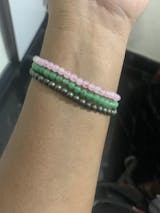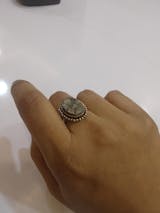The association of Peridot with August can be traced back to the ancient practice of aligning specific gemstones with the months of the year. This tradition has evolved into the modern birthstone system. Peridot is particularly fitting as the birthstone for August, not only because of its vibrant, summery color but also because of its historical significance and the qualities it is believed to bestow upon the wearer.
In astrology, Peridot is linked to the sun sign Leo, which falls partly in August, reinforcing its connection to the vibrancy and warmth of the sun. Peridot is believed to bring the wearer power, influence, and a sense of calmness. Its light green color reflects the life and nature thriving during August, symbolizing prosperity and new beginnings.
History Of Peridot
Peridot also known as the "gem of the sun" to the ancient Egyptians, Peridot has been treasured since early civilizations for both its beauty and supposed protective powers. Mined from the volcanic sands of Egypt's St. John's Island (now Zabargad) for over 3,500 years, Peridot was believed to ward off evil spirits, especially when set in gold.In Bible it is mentioned as one of the stones in the breastplate of the High Priest, symbolizing the tribe of Simeon. Throughout history, Peridot has been associated with light and protection, believed to promote health and wealth and drive away darkness's forces.
Historians believe Cleopatr’s "emeralds" were actually peridots. Peridot adorned the Shrine of the Three Holy Kings and gained popularity in Europe during the Crusades and later in Victorian and Edwardian jewelry.
Where is Peridot Found?
Peridot, a member of the olivine mineral family, comes in shades of green, with its color determined by the amount of iron it contains. Uniquely, Peridot forms both in the Earth's mantle and in meteorites from space. Most Peridots are brought to the surface through volcanic eruptions, while some are found in meteorites, making it one of the few gemstones with both terrestrial and extraterrestrial origins.
Peridot is mined worldwide, with notable sources including Myanmar, Pakistan, and the United States, particularly Arizona, known for its bright lime green stones. Other sources include China, Vietnam, Brazil, Norway, and Kenya. Each location produces unique Peridots, showcasing diverse geological conditions. Peridot's journey from deep within the Earth, and sometimes even from space, adds to its unique appeal as a gemstone prized for its vibrant color and fascinating origin.
Symbolism Of Peridot
Peridot symbolizes positivity, protection, and abundance. Known as the "gem of the sun," it is believed to bring good fortune, reduce stress, and promote healing. Many cultures associate Peridot with strength and the ability to ward off negative energy, making it a popular stone for emotional balance and spiritual growth. Its vibrant green color also represents renewal and prosperity. The choice of Peridot as the August birthstone is also rooted in its symbolic representation of strength and resilience.
Properties
In crystal healing, Peridot is celebrated for its vibrational energy that aligns with the heart chakra, the center of compassion and love. This alignment is believed to facilitate healing emotional wounds, fostering a sense of well-being and contentment. Here are some of the key benefits attributed to Peridot in crystal healing practices:
Emotional Healing
Peridot releases negativity, such as jealousy, resentment, and spite. Its energy promotes understanding and insight, helping individuals overcome emotional hurt and embrace personal growth.
Stress Relief
Peridot's calming green light is thought to soothe tense emotions and alleviate stress. It's also believed to encourage relaxation and rejuvenate the mind, making it easier to navigate life's challenges with a balanced perspective.
Physical Wellness
Crystal healers often recommend Peridot for its supposed ability to detoxify the body and enhance overall vitality. It is associated with tissue regeneration, strengthening of metabolism, and improvement of the skin.
Protection
Peridot is also considered a protective stone, shielding the wearer from negative energies and influences. This includes protection from the envious thoughts of others, as well as guarding the spirit during periods of personal growth and change.
Attracting Prosperity
Beyond its healing properties, Peridot is believed to attract love, wealth, and abundance. Its bright, positive energy is said to open doors to new opportunities and bring joy and fulfillment.
Discover the vibrant energy of Peridot, a gemstone known for its healing, protection, and prosperity. Add this powerful stone to your life by exploring our Peridot collection here.
Caring for Peridot
Caring for Peridot requires gentle handling to maintain its beauty and prevent damage. It’s a relatively soft gemstone, so proper care ensures its vibrant color and clarity last for years.
- Clean Gently: Use mild soap and lukewarm water to clean Peridot. Avoid harsh chemicals and ultrasonic cleaners, as they can damage the stone's surface.
- Avoid Heat: Keep Peridot away from high temperatures or direct sunlight for long periods, as heat can cause the color to fade over time.
- Store Carefully: Store Peridot separately from other jewelry in a soft pouch or lined box to prevent scratches, as it can be easily damaged by harder gemstones.
- Remove During Activities: Take off Peridot jewelry before engaging in physical activities, like cleaning or sports, to protect it from accidental knocks or abrasions.
- Check for Damage: Regularly inspect the gemstone and its setting for any signs of wear, and have a professional jeweler repair loose stones or damaged prongs.
Peridot, with its vibrant green hues, embodies the essence of summer and nature's rejuvenating power. As the birthstone of August, it symbolizes strength, healing, and prosperity. Peridot's rich history and mythological significance add depth to its beauty, making it more than just a gemstone. Whether worn daily or for special occasions, Peridot's versatility in jewelry design reflects its timeless appeal. Its healing properties and connection to nature attract both those who believe in its energies and those who simply appreciate its beauty. Explore Peridot's allure, and let it add elegance and meaning to your life.














